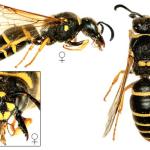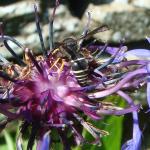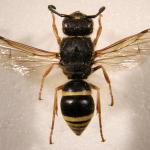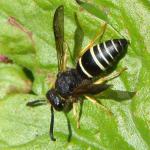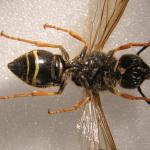Ancistrocerus pictus (Curtis, 1826)
Previously known as Ancistrocerus pictus (Curtis, 1826). A colour form with very pale yellow to ivory-white tergal bands is found in Ireland and the Outer Hebrides: elsewhere the bands are bright yellow. Identification keys and general biology are given in Bignell (1881, 1882), Nielsen (1932), Spradbery (1973), Richards (1980), Gusenleitner (1995) and Yeo & Corbet (1995).
Found throughout England, Wales, Scotland (except Orkney and Shetland), Ireland and the Channel Islands.
Overseas, occurs in many parts of Europe (Norway, Sweden, Finland, Denmark, The Netherlands, Belgium, France, Spain, Portugal, Germany, Italy, Poland, Austria, Albania, Bulgaria, Georgia), North Africa (Morocco), Asia (Transbaikal, Manchuria, Mongolia, Japan). In central Europe found in mountainous areas up to 2000 m.
Not listed in Shirt (1987) or Falk (1991); work for this Atlas suggests that the species is possibly declining in central and eastern England.
Found in a wide variety of habitats: moorland, lowland heaths, clay and sandy woodlands, parkland, limestone and chalk quarries, calcareous grassland, coastal cliffs, sand dunes and urban areas (gardens and cemeteries).
Probably univoltine; mostly May to July, sometimes during August, and rarely in April, September and October.
Microlepidoptera larvae, usually tortricids.
A mud-dauber building with clay. Its nest consists of several cells (usually 3-5, but up to 14 have been recorded), covered by a layer of protective, camouflaging mud. Nests may be found on walls, stone columns, concrete blocks, and rocks; often using crevices and indentations. Also recorded nesting in a lock (Sheppard, 1926) and in the holes of an oak cribbage board. Initially a row of cells is built on the substrate with additional cells placed on top. Usually four or five prey are placed in each cell. The larval stage lasts about 15 days.
Privet, thistles and sea-holly.
Chrysis ruddii Shuckard (Morgan, 1984) and probably C. ignita (Linnaeus) or C. impressa Schenck (Bignell, 1882).
1998


